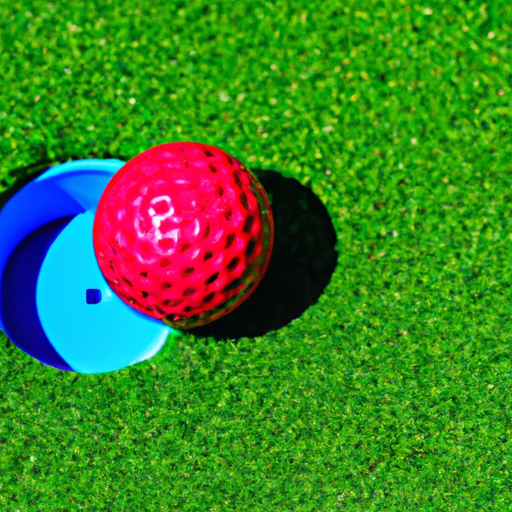Whether you’re a seasoned golfer looking for a fun change of pace or a complete novice stepping onto the green for the first time, mini golf offers an enjoyable and challenging experience for players of all levels. But amidst the laughter and friendly competition, it’s important to keep track of your score accurately. In this beginner’s guide, we’ll walk you through the simple steps and strategies for keeping score on a mini golf course, ensuring you can focus on having a fantastic time while still keeping tabs on your performance. So grab your putter and let’s dive into the world of scoring on mini golf!

Equipment and Materials
Putters
When playing mini golf, the most essential piece of equipment you’ll need is a putter. Putters are specially designed clubs that are used to strike the golf ball and guide it towards the hole. They are typically shorter in length compared to regular golf clubs, allowing for more control and precision when putting.
Golf Balls
Just like in regular golf, you’ll need golf balls to play mini golf. These balls are smaller and lighter than traditional golf balls, making them perfect for navigating through the miniature obstacles on the mini golf course. It’s recommended to have a few extra golf balls on hand in case you lose one during your game.
Scorecard
To keep track of your score and the scores of your fellow players, you’ll need a scorecard. Scorecards often come pre-printed with the layout of the holes on the mini golf course, allowing you to easily record your scores as you move from one hole to another. Scorecards typically have designated areas for each player’s name and the score for each hole.
Pencil
Lastly, don’t forget to bring a pencil or two to mark down your scores on the scorecard. While some mini golf courses may provide pencils, it’s always a good idea to have your own just in case. A regular pencil works great, but if you prefer something more permanent, consider using a small marker or pen that won’t easily smudge.
Understanding the Basics
Objective of Mini Golf
The objective of mini golf is simple: to complete each hole with the fewest number of strokes possible. The ultimate goal is to sink your golf ball into the hole in the least amount of shots. Mini golf courses are designed with various obstacles such as ramps, tunnels, and barriers, which add an element of challenge and fun to the game.
Number of Holes
Most mini golf courses consist of 18 holes, just like in traditional golf. However, you may occasionally come across mini golf courses with fewer or more holes. Regardless of the number of holes, the basic principles of keeping score remain the same.
Stroke Limit
Each hole in mini golf has a stroke limit, also known as a par. This refers to the maximum number of shots allowed to complete the hole. If you exceed the stroke limit, you will be assigned a penalty stroke and your score for that hole will reflect the total number of strokes taken, including the penalty.
Scoring System
Stroke Count
The primary method of keeping score in mini golf is by counting the number of strokes taken on each hole. Each time you strike the golf ball, it counts as one stroke. The objective is to complete each hole in as few strokes as possible, aiming for a low overall score at the end of the game.
Tracking Scores
To track scores accurately, it’s important to record the number of strokes taken by each player on their respective scorecards. As you move from hole to hole, ensure that you update the scorecard with the correct number of strokes for each player. This will help you keep an accurate tally for the entire game.
Penalties
In some cases, players may incur penalty strokes based on certain circumstances. These penalties are typically assigned for violations such as hitting the ball out of bounds, going over the stroke limit for a hole, or interfering with another player’s ball. Penalty strokes are added to the player’s total stroke count for that particular hole.

Starting the Game
Tee Positions
Before you start playing, it’s important to understand the tee positions. The tee is the designated starting point for each hole. Mini golf courses often have multiple tee positions, each offering a different level of difficulty. Players can either choose a specific tee position or follow a predetermined rotation.
Deciding Order
To determine the order of play, players can use various methods. One common method is to have each player take turns teeing off, starting with the player whose name comes first in alphabetical order. Another approach is to use random selection, such as drawing straws or flipping a coin. Ultimately, the order of play should be fair and agreed upon by all players.
Order of Play
Once the order of play is established, players take turns hitting their golf balls. The player who is farthest from the hole typically plays first, followed by the player with the next farthest ball, and so on. This rotation continues throughout the game, ensuring that everyone has a chance to play in a fair and orderly manner.
Recording Scores
Using a Scorecard
A scorecard is an indispensable tool for keeping track of scores in mini golf. It provides a pre-designed layout of the holes, allowing you to easily mark down the number of strokes taken by each player. Most mini golf courses will provide scorecards, but if not, you can create your own by drawing small circles or squares to represent each hole.
Writing Down Scores
To record scores on the scorecard, find the designated area for each player’s name and enter their initials or full name. Next, locate the first hole and write down the number of strokes taken by the player for that particular hole. Repeat this process for all subsequent holes, ensuring accuracy and clarity when recording the scores.
Calculating the Total
To determine the total score at the end of the game, simply add up the number of strokes for each hole. The player with the lowest total score is considered the winner. Take your time when tallying the scores to avoid any mistakes, as accuracy is crucial when determining the final outcome of the game.
Counting Strokes
Counting Each Shot
In mini golf, it’s important to count every shot you take, even if it doesn’t go as planned. Each time you strike the ball, it counts as one stroke regardless of the outcome. Whether the ball goes into the hole, hits an obstacle, or ends up in a less desirable location, make sure to count each shot accurately to maintain a fair and transparent score.
Penalty Strokes
Penalty strokes come into play when a player violates a rule or goes over the stroke limit for a particular hole. These strokes are added to the player’s total score for that hole, reflecting the consequences of their actions. Penalties are typically determined by the mini golf course’s specific rules, so it’s important to familiarize yourself with them before starting the game.
Assigning Points
Awarding Points
In mini golf, points are not typically awarded as in other sports. Instead, players aim for a low score by trying to complete each hole in as few strokes as possible. The player with the lowest total number of strokes at the end of the game is considered the winner. However, if you prefer to introduce a point-based system for added competition, you can do so by assigning various point values to different achievements, such as holes-in-one or completing a hole under par.
Scoring Options
While the primary scoring method in mini golf involves counting strokes, players can also use alternative options for a more personalized experience. Some mini golf courses may utilize a scorecard that includes spaces for assigning points based on performance or specific challenges within each hole. These options can add a layer of strategy and creativity to the game, making it even more enjoyable for participants.
Special Scenarios
Mini golf often presents special scenarios where players have the opportunity to earn additional points or face unique challenges. These scenarios can include obstacles that grant bonus strokes, hidden shortcuts, or special holes with enhanced difficulty. Embrace these special scenarios as they add excitement and unpredictability to the game, making each round of mini golf a thrilling adventure.
Differences in Scoring
Variance in Rules
Scoring methods in mini golf can vary from one course to another. Some courses may have specific rules and regulations that differ from the standard stroke count method. For example, a course may assign a set number of strokes per hole rather than allowing players to continue until the ball is sunk. It’s important to familiarize yourself with the specific rules of the mini golf course you are playing on to ensure fair play and accurate scoring.
Unique Course Rules
Certain mini golf courses may have their own unique scoring rules or bonus opportunities. These rules can range from rewarding hole-in-one shots with fewer strokes to imposing additional penalties for certain hazards on the course. Understanding these unique rules will not only enhance your overall experience but also help you adjust your strategy accordingly.
Alternative Scoring Methods
While counting strokes is the traditional scoring method in mini golf, you and your friends can choose to use alternative scoring methods for a more diverse and enjoyable game. For example, you can assign point values to different obstacles or award bonus points for creative shots that navigate around tricky obstacles. The goal is to customize the scoring system to your preference and make the game more exciting.
Friendly Competition
Playing with Friends
Mini golf is a fantastic activity to enjoy with friends. Whether you’re playing casually or engaging in friendly competition, the game offers a great opportunity for socializing and bonding. Take turns teeing off, discuss strategies, and cheer each other on as you navigate the course. Remember, it’s not just about the final score, but the memorable moments you create with your friends along the way.
Creating Tournaments
To add an extra layer of excitement to your mini golf experience, consider organizing a tournament with your friends or fellow players. Create a bracket-style competition, establish a prize for the winner, and watch the friendly rivalry unfold. Tournaments can be a fun way to bring out everyone’s competitive spirit and create lasting memories.
Celebrating the Winner
At the end of your mini golf game or tournament, be sure to celebrate the winner’s achievement. Congratulate them on their victory and acknowledge their skill and resilience throughout the game. Recognizing the winner’s success not only shows good sportsmanship but also encourages a positive and encouraging atmosphere for future games.
Etiquette and Fair Play
Follow the Course Rules
To ensure a fair and enjoyable game for everyone, it’s important to adhere to the course rules. Familiarize yourself with the specific rules of the mini golf course you are playing on and make sure to follow them while playing. These rules are designed to maintain fairness, safety, and an equal playing field for all players.
Respecting Other Players
Mini golf is a game that relies on good sportsmanship and respect for fellow players. Avoid distracting or disturbing other players while they are taking their shots. Wait patiently for your turn and refrain from making unnecessary noise or movements. Remember, everyone is there to have a good time, so make sure to create a positive and respectful environment for everyone involved.
Resolving Conflicts
In any game, conflicts can arise. Whether it’s a dispute over the score, interference on the course, or disagreements about rules, it’s important to address and resolve conflicts in a calm and respectful manner. Engage in open communication, listen to each other’s perspectives, and strive to find a fair resolution. Remember, mini golf is meant to be a fun and enjoyable experience, so prioritize resolving conflicts quickly to maintain the positive atmosphere of the game.
Keeping score in mini golf is not only a fundamental part of the game but also an exciting way to track your progress and compete with friends. By understanding the basics, familiarizing yourself with the scoring system, and embracing the friendly competition, you’ll be well-equipped to enjoy a memorable and competitive mini golf experience. So grab your putter, golf ball, scorecard, and pencil, and get ready for a delightful journey through the miniature world of mini golf!
